#decapod
Explore tagged Tumblr posts
Text


Salem Cave Crayfish (Cambarus hubrichti), family Cambaridae, order Decapoda, MO, USA
photograph via: Missouri Bat Census
1K notes
·
View notes
Text
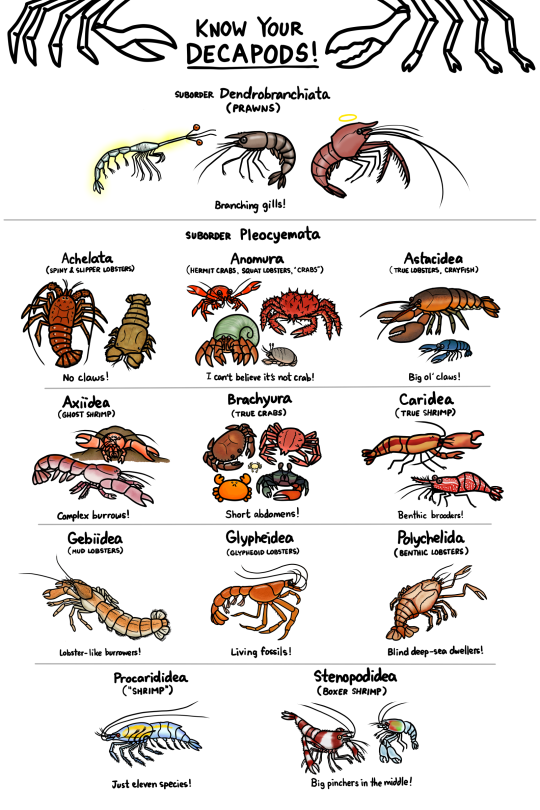
Decapocember Day 14: Know your Decapods!
Available as a print, just in time for holiday gift-giving!
3K notes
·
View notes
Text

drew this back in June, Eryon is ready to throw hands (claws)
#jurrasic june#jurrasic#paleoart#paleo art#palaeoblr#eryon#crustacean#decapod#extinct animals#prehistoric
2K notes
·
View notes
Text

Click here for a big ass database all about crustaceans. [No, they didn't sponsor me :( ]

#marine biology#crab#crab day#crustacean#decapod#crabs#decapoda#fiddler crab#adhd brain#hyperfixation#pirates#fishblr
509 notes
·
View notes
Text
Wet Beast Wednesday: pistol shrimp
Oh snap, it's the snapping shrimp post for Wet Beast Wednesday! Snapping shrimp or pistol shrimp are loud little critters that have evolves a very useful and fascinating tool in their pincers. Let's not waste time and shoot off to learn about these little gunslingers.
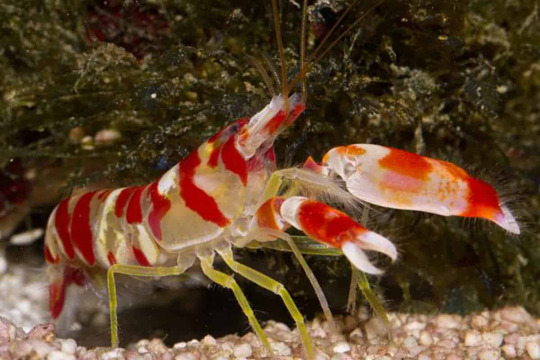
(Image: a pistol shrimp. It is a mostly white shrimp with red stripes. One of its claws is considerably larger than the other. It is standing on gravel and next to some seaweed. End ID)
Pistol shrimp are over 1,000 members of the family Alpheidae, which is part of the infraorder Caridea. This means they are true shrimp, not to be confused with superficially similar animals like brine shrimp, mantis shrimp, tadpole shrimp, and prawns. Yeah, I only recently learned that prawns and shrimp aren't a language difference between British English and American English like chips vs fries. They're not even that closely related. As true shrimp, pistol shrimp have two main body parts: the cephalothorax and abdomen, which are composed of 19 body segments. The abdomen forms a flexible tail with a fin on the end. When startled, the fin can rapidly curl under the body, propelling the shrimp backwards. Like other decapods, there are 10 limbs. The front pair of limbs have evolved into claws used to manipulate objects. The claws are the most distinguishing feature of pistol shrimp. They are asymmetrical, with one growing extremely large, over half the size of the body. The big claw has a modified version of the typical pincer. This pincer has an upper claw that can open up at a right angle. Under the claw is a pocket in the lower pincer, into which water flows. The upper pincer then slams down into this pocket, forcing the water out. The pressure of the pincer closing water in the pocket creates a cavitation bubble that is forced away from the claw at up to 26.8 meters per second. This is enough force to seriously wound small animals and hurt larger ones into leaving the shrimp alone. The cavitation bubbles can reach up to 4,427 degrees C (8,000 F) . For comparison, the surface of the sun is about 1,000 decrees (C) hotter. When the bubble pops, it creates a snapping sound that can reach 218 decibels. For comparison, most gunshots max out at around 170 db. This puts pistol shrimp is the running for the loudest ocean animals, with whales being the other main competitors. If that all sounds like a lot, the whole event happens so fast that the heat doesn't have time to affect much and the noise sounds like a moderately loud snap to us. Adults can snap their claws shut with an acceleration of up to 30 meters per second squared and juveniles can do it up to 20 times faster. The whole process takes less than a millisecond. When the cavitation bubble collapses, it can produce light. This is called sonoluminescence and nobody knows how it happens. If a pistol shrimp loses its large claw, the small claw will grow into a new large one while the missing limb will regenerate into a small claw. Adult pistol shrimp average between 3 and 5 cm long.
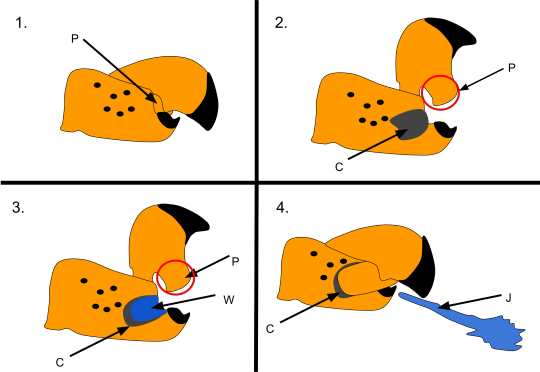
(Image: a drawing showing the process of a pistol shrimp snapping its claw. In the first panel, the claw is closed. In the second, the upper claw opens at a 90 degree angle, revealing a cavity. In the third panel, the cavity fills with water. In the final panel, the claw is closed again and a jet of water is ejected from the claw. End ID. Source: Wikipedia user Carermyers)
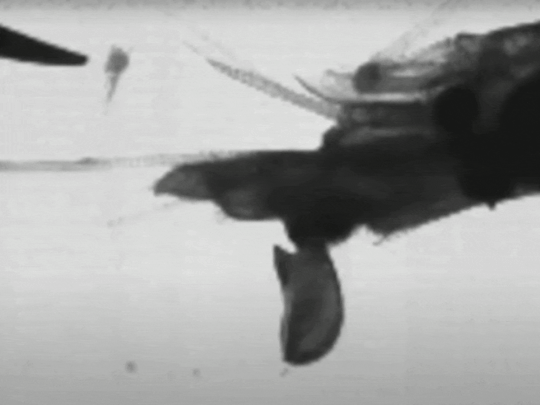
(Gif: black and white, slow-motion video of a pistol shrimp's claw snapping shut and creating a cavitation bubble. End ID. Source)
Pistol shrimp live worldwide, though most species live in tropical or temperate water. There are some cold water species and even freshwater species. Most prefer habitats where they can make burrows and where there are plenty of other animals. Coral reefs, oyster reefs, seagrass beds, mangrove groves are common habitats. Snapping is used for hunting and communication. They typically hide in burrows, waiting for fish or other small animals to pass by. When prey passes, the shrimp will snap to stun or seriously wound the prey, then drag it into the burrow. Some social species actually form eusocial hives with a single queen who produces all offspring. These shrimp are the only known marine eusocial species and all occur within the same genus (Synalpheus), though not every member of that genus is eusocial and eusociality appears to have evolved at least 3 times within that genus. It appears that a reason why only this genus developed eusociality is their larvae do not disperse, instead staying in the same area as the parents. The hives are usually located within sponges. Other social species are not eusocial, but still live together in colonies. Many less social species have formed a symbiotic relationship with gobies. Both species live in burrows, but gobies are bad at digging while the shrimp have poor eyesight. The goby will protect the shrimp while it digs a burrow, then the two live together. They will forage together, with the goby using its superior eyesight to watch for predators and warn the shrimp to get back to the burrow. Pistol shrimp are monogamous, the same pair coming back to mate over and over again (this does not apply to the eusocial species in which only the colony's queen is permitted to mate). The female is only fertile during a short period after molting. The male will stay with the female and protect her during the vulnerable period after mating and some species will remain with each other until the eggs hatch or permanently.
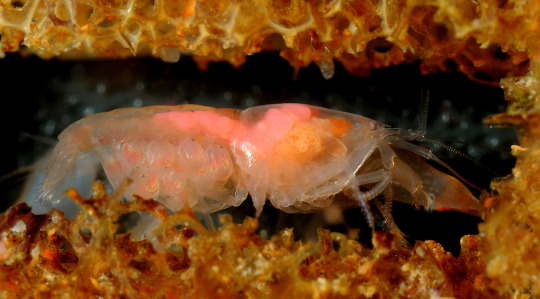
(Image: a eusocial pistol shrimp queen with eggs. Her body is translucent and multiple eggs are attached to her abdomen. The eggs look like translucent balls. The is inside of an orange sponge. End ID)
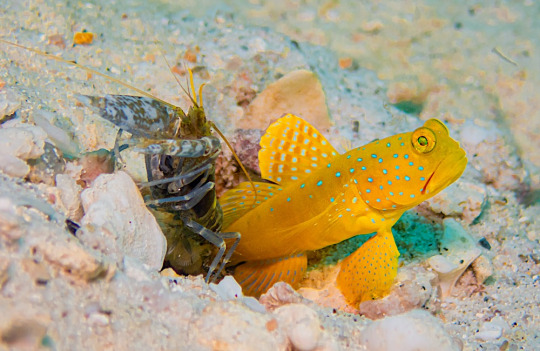
(Image: a pistol shrimp and goby emerging from a burrow in the sand. The shrimp is a mottled green and white. The body is a bright yellow fish covered with blue spots. End ID)
Pistol shrimp are a major source of noise in the places where they live. If you've ever been swimming and can hear repeated cracking noises, that may have been a bunch of pistol shrimp. Some scientists monitor the level of pistol shrimp noises as a method of monitoring the ecosystem. If the noise level drops, that is an indicator that the local ecosystem is suffering. The noise of the shrimps can get so loud that it actually interferes with sonar and forms of underwater communication. During World War II, members of the navy realized that the shrimp disrupted sonar enough to hide submarines, so they started hiding submarines near reefs with lots of the shrimp to keep them from being found by enemy subs. Weirdly not the only small marine animals to mess with submarines. I'll get the the other major one soon. The largest threats to pistol shrimp come from habitat destruction. Some species of pistol shrimp have entered the pet trade. As coral reefs, seagrass beds, and other habitats are destroyed, the shrimp that rely on them will suffer as well.

Yet another time I get to use one of these cards in a post
(Image: the Weird n' Wild Creatures card featuring pistol shrimp. End ID)
#wet beast wednesday#pistol shrimp#snapping shrimp#shrimp#decapod#crustaceans#marine biology#biology#zoology#ecology#animal facts#eusocial#symbiosis#goby#informative#image described
243 notes
·
View notes
Text

By ondrej-radosta, CC BY-NC
#lollipop crab#crab#decapod#crustacean#arthropod#friday poll#i keep seeing pics of these guys but can't find a lot of information about them#or a lot of photos under free-to-use licensing tbh...
50 notes
·
View notes
Text

White Lobster
#animal#picture#invertebrate#lobster#Nephropidae#Crustacean#live animal#aquatic#aquatic animal#decapod
41 notes
·
View notes
Text


Ragu has been casting spells all day what do I do with them
#silly little guy#crayfish#virile crayfish#freshwater aquarium#freshwater biology#arthropods#crustacean#decapod#marine biology#keeperposting
43 notes
·
View notes
Text







Mommy crayfish and her baby crayfish <3
Korean Crayfish (Cambaroides similis)
#photographers on tumblr#my photography#original photographers#art#lensblr#photography#animal photography#wildlife photography#macro photography#nature photography#nature#wildlife#naturecore#crustacean#decapod#cambaroididae#crayfish#freshwater#freshwater fish#freshwater ecology#korea#korean#september 11 2024#no to generative ai
25 notes
·
View notes
Text
Remember this post I made?
Well I'm back with something pretty special: Some pictures of the diagrams from said book! The book is Trinidad Naturalist Volume 2 No. 12, and it was published in November/ December of 1979!
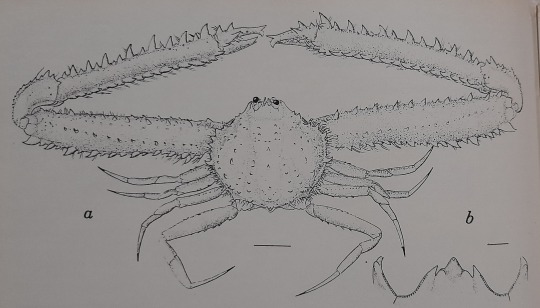

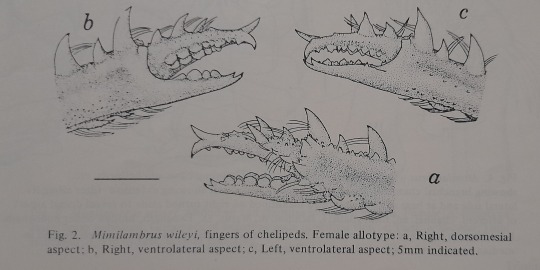
[Image ID: Several diagrams of a crab, showing the closeup of the palps and claws. The paper is slightly brownish, showing that the book have considerable age. /End ID]
@revretch, @bogleech and maybe @vintagewildlife, I think you'll be interested in this? Especially since this book have interesting pictures in some of the articles as well.
#OCTAfan says stuff#vintage illustration#scientific illustration#Crab#Decapod#Mimilambrus Wileyi#Ask to tag
101 notes
·
View notes
Note
i had a blast at an aquarium today and by far my favourite things to see were the shrimps, do you have any shrimp species you like best? :> (also i love ur blog! i love seeing cool animal stuff so tysm for sharing pics and knowledge!!)
I am a fancy gentleman, and I love some fancy shrimps...

Harlequin Shrimp (Hymenocera picta), family Palaemonidae, Lembeh, Indonesia
photograph by Christian Gloor

Harlequin Shrimp (Hymenocera picta), family Palaemonidae, found in tropical reefs in the Indian and Pacific Oceans
photograph by Steve Childs

Harlequin Shrimp (Hymenocera picta), family Palaemonidae, Tulamben, Bali, Indonesia
photograph by Ronen Avigdor
692 notes
·
View notes
Text
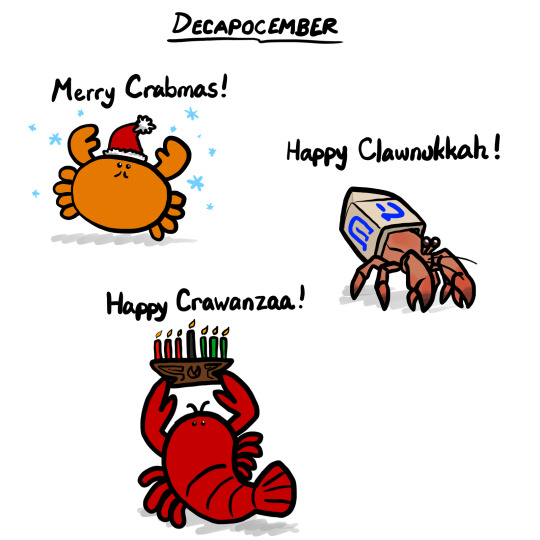
December is for Decapods!
5K notes
·
View notes
Text
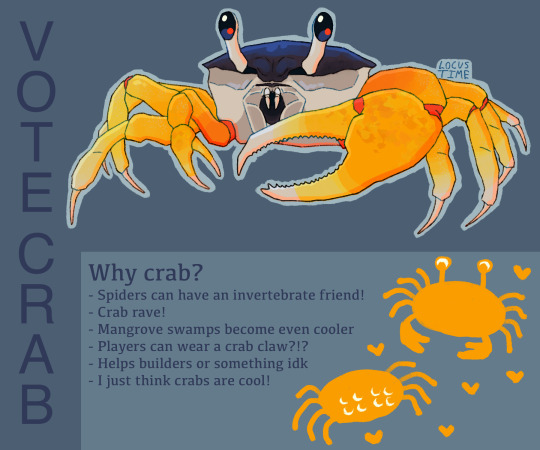
my thoughts on the mob vote
#in all seriousness I would be happy regardless of who wins. however crab is the strongest candidate imo#its the mob I’d enjoy the most#penguins don’t bring that much other than cuteness#but I think crabs are also cute :)#and armadillos. all the armadillo fans I see don’t even want the armadillos they just want wolf armour#which is cool but like. crabs.#I want a mob I can enjoy#locus art time#minecraft#<- I guess??#minecraft mob vote#mob vote#vote crab#mob vote 2023#digital art#art#artists on tumblr#bug#decapod#crustacean#crabs#fiddler crab#crabs are so hard to draw (and this is coming from someone who draws bugs on the regular) like its not even funny#bug art
61 notes
·
View notes
Text
Atlantic Ghost Crab, [The Cannibal]
[Ocypode Quadrata]
Ready to learn about the Hannibal Lecter of crustacean family? Hop on board!
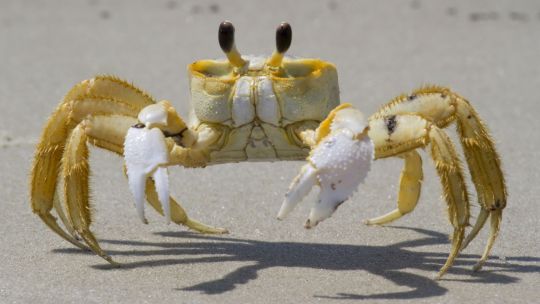
Starter : The Atlantic ghost crab, Ocypode quadrata, is a species of ghost crab. It is a common species along the Atlantic coast of the United States, where it is the only species of ghost crab.
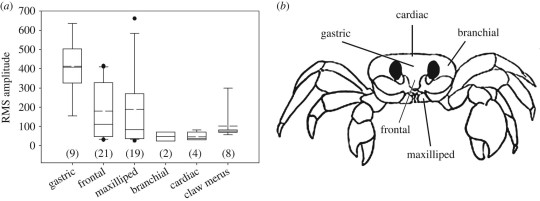
Some fun facts about this good spooky fella!
A 2023 study using the well known mirror test found that these crabs seem to be capable of recognizing themselves in a mirror. They are self-aware.
The atlantic ghost crabs must return to water periodically to moisten their gills, and when larvae must be released into the sea, but they are otherwise terrestrial.
Their stalked compound eyes can swivel to give them 360° vision.

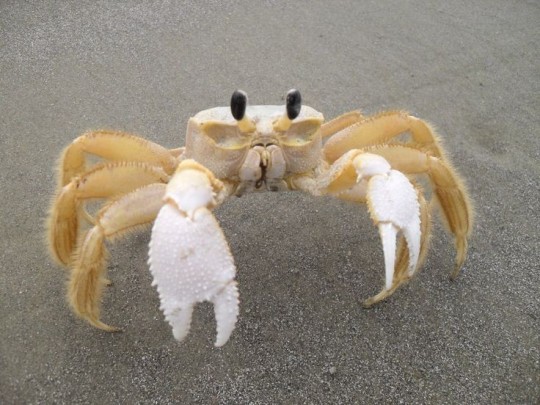

Fun Fact! Ghost crabs are arguably the fastest terrestrial invertebrates, capable of running at more than a meter per second.
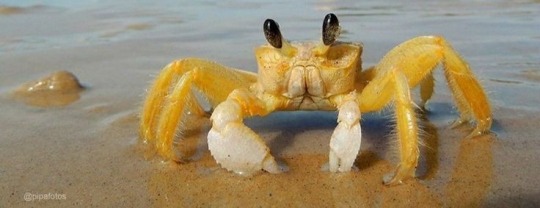
The Atlantic ghost crab lives in burrows (like fiddle crabs!) in sand above the strandline.
These burrows can be up to 1.3 m (4'3) deep, and can be closed off with sand during hot periods.
Young crabs are cryptically colored to blend in with their sandy habitats. This way predators are less likely to see them.
Ghostie mate can produce a variety of sounds by striking the ground with the claw, by stridulation with the legs, and an incompletely explained "bubbling sound"

O. quadrata is more active at night than in the day, and is an omnivore, eating clams, mole crabs, insects, plant material, detritus, and even other crabs. They also feed on the eggs and hatchlings of sea turtles.
CANNIBALISM!? Traitors shall walk the plank!
Ghost crabs are both predators and scavengers, and they feed at night. Their prey can be influenced by the type of beach they live on.
These fuckers arr' also mostly carnivores. They got taste, don't they?
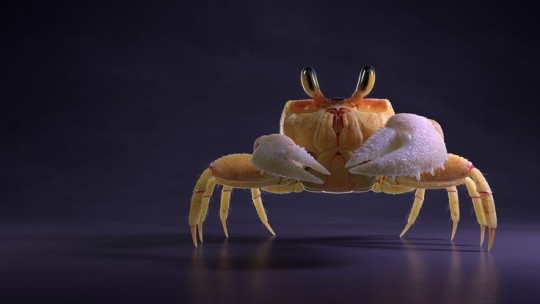

Pic by Eugene Bobylev | [Credits] | [Credits]
#crab#tumblr crabs#crabs#crustacean#decapod#decapoda#crab day#marine biology#fishblr#fiddler crab#sea life#ocean life#biology#adhd brain#hyperfixation#captain kuppa
130 notes
·
View notes
Text
Wet Beast Wednesday: American lobster
This series takes us all over the world, but today we're going back to the good-ol' burger-drinking, beer-eating, eagle-worshiping U-S-of-A! The American lobster may be the world's most famous crustacean as they have become a major source of overpriced seafood. There's a lot to learn about this critter, so let's go check out the crustacean sensation that's sweeping the nation.

(Image: an American lobster seen from the side. It is a crustacean with 8 legs, a pair of large pincers, and a pointed head that has two long antennae and small eyes. The abdomen in elongated and segmented and ends with a fan-shaped tail. It is a greenish-brown color. End ID)
Homarus americanus is the largest lobster and largest crustacean, reaching a maximum recorded length of 64 cm (25 in) and weight of 20.1 kg (44.4 lbs). The average size is between 20 and 61 cm (8-24 in) and 680 to 910 grams (1.5-2 lbs). Lobsters are members of the family Nephropidae and despite the common names, they are not closely related to squat lobsters, slipper lobsters, or spiny lobsters. They are, however, closely related to crayfish. Lobsters are decapods, crustaceans with 10 limbs. Of the 5 pairs of limbs, the rear 8 are used for walking and the front two have become enlarged into a pair of powerful pincers used for defense and offense. The claws are asymmetrical and each serves different purposes. One claw is large and stout, with rounded, molar-like growths on the cutting edge. This claw is called the crusher claw and it is used to crush through hard-shelled food. The other claw is more slender and has a sharper cutting edge. This is the scissor claw and it is used to cut soft food into small enough pieces to eat. The crusher and scissor claws can be on either side of an individual lobster and very rarely a lobster will grow two crushers or two scissors instead of one of each. While the pincers can close with incredible force, they can't open with much force. This allows them to be held shut with rubber bands. The front two pairs of walking legs also have pincers, but they are much smaller. Lobsters can regrow missing legs. It can take up to 5 years for a missing pincer to regrow to the size of the original.

(Image: a lobster seen from the front, with the pincers in prominent view. One claw is bulkier than the other. The bulky claw has rough nodules on the cutting edge. The skinnier claw has serrated spines on the cutting edge. end ID)
Lobster anatomy is divided between two major segments: the cephalothorax and the abdomen. The cephalothorax contains the mouthparts, brain, legs, and many sensory organs. While they have eyes, they are weak due to lobsters spending most of their time on murky seafloors. Taste, smell,and touch are their primary senses. Antennae are used to examine the world and both the antennae and legs have sensory hairs called antennules on them that can detect the presence of chemicals in the water. Lobsters can both detect the smell of food and determine which direction it is coming from. The antennules also detect the motion of the water. Lobsters also urinate from a pair of bladders on the sides of the head. They can adjust the scent of the urine to communicate with each other. That's right, lobsters communicate by peeing on each other from their faces. The mouthparts consist of leg-like structures called maxillipeds that grab food and mandibles that help rip food up. Lobsters can't chew their food, but they have a structure in the esophagus called a gastric mill that grinds food down as it is swallowed. The abdomen is long and consists of multiple segments, allowing for flexibility. On the underside of the abdomen are feathery appendages called pleopods or swimmerettes. The first pair of swimmerettes is modified into sex organs called gonopods which can be used to differentiate males from females. The remaining pairs are used to circulate water around the lobster, helping keep fresh water over the internal gills. At the tip of the abdomen is a large, fan-shaped tail. By quickly curling the abdomen under their bodies, lobsters can generate thrust and send themselves shooting backwards. This is done to escape perceived threats.

(Image: a lobster standing on sand with its abdomen curled under its body. End ID)
Like other crustaceans, lobsters periodically outgrow their exoskeletons and must molt. After molting, the lobster will have a new, soft exoskeleton that takes time to harden. This period of softness leaves lobsters much more vulnerable to predators, so they will usually hide until their new shell hardens. They also eat the old shell to regain the nutrients and minerals it holds. The period after molting is also when females become fertile. A molted female will release pheromones that attract males. The male performs a courtship dance and if the female approves, he will use his gonopods to transfer a packet of sperm into her shell. The female can store this packet for over a year before using it. She lays thousands of eggs at once eggs and fertilizes them with the sperm as they come out. The eggs stick to her swimmerettes and she will work to keep them clean and keep air circulated over them. The clusters of eggs allegedly look similar to raspberries and a female with eggs is said to be "in berry". I personally don't see it. The eggs develop for 10 to 11 months before hatching, wherupon the female shakes her tail to dislodge the larvae. The larvae start out as a tiny, planktonic form called a metanapulus that drifts near the surface of the water and eats plankton. After their 4th molt, the larvae takes on a sub-adult form more similar to an adult, though they are still small enough to swim with their swimmerettes. Approximately 1 in 1,000 larvae will live long enough to reach this stage. After another molt, the sub-adult takes on its final form and sinks to the bottom, where they will gradually grow into an adult. Lobsters molt up to 10 times in their first year, then may one molt once every few years. By the time a lobster is large enough for anglers to legally keep, they will have undergone around 25-27 molts. There isn't really a maximum age for lobsters. They don't go through the same aging process as most animals. Lobsters have the ability to repair the damage to DNA that causes aging. While they will not age to death, you are unlikely to find thousand year old lobsters roaming about. Each molt takes more energy than the previous one and a lobster that doesn't die of predation, disease, or injury will eventually become unable to complete a molt and will die as a result. Most estimates place the maximum age for lobsters at about 100 years, but there are unconfirmed reports of lobsters reaching 140 years.
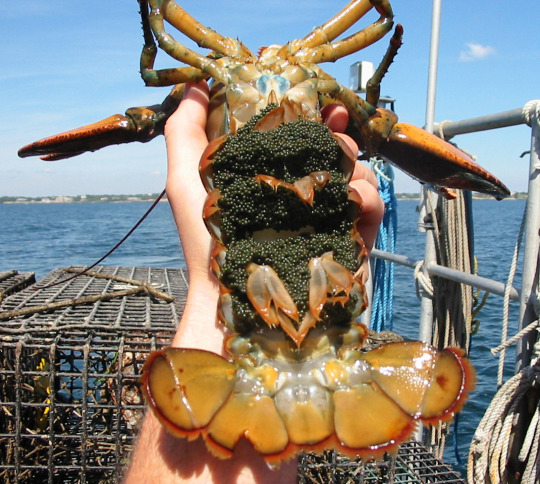
(Image: somebody holding a lobster so the underside of the abdomen is visible. This lobster is a female with masses of small, black eggs on her abdomen. End ID)
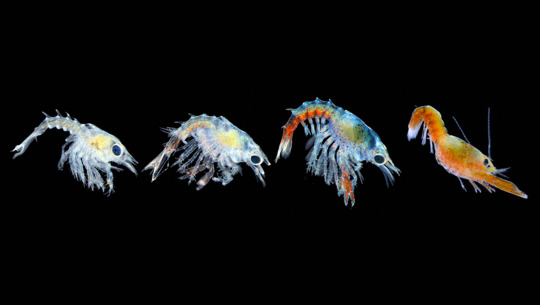
(Image: A lobster larva shown in the first four molts. The first three stages look more like transparent shrimp than lobsters. The final stage looks that a miniature lobster and is orange. End ID)
You would be hard-pressed to find a fictional depiction of a lobster that isn't bright red, but wild lobsters aren't that color. Most range from greenish-blue to greenish-brown, good colors for hiding amongst rocks and seaweed. That being said, American lobsters are famous for their wide range of color variants. Lots of people have herd of blue lobsters, but there are actually quite a few color options caused by genetic traits that overproduce certain pigments. Because of the rareness of these traits and the colorful lobsters being more at rick of predation, they are quite rare. Still, many color variants have been seen including blue ( 1 in 10 million lobsters), red (though not as bright as cooked lobsters. 1 in 30 million), bright yellow (1 in 30 million), calico (yellow and blue spots, 1 in 25 million), split down the middle (1 in 50 million), and white (albino or leucistic, 1 in 100 million). Many lobster anglers seem to agree that if they catch colored lobsters they should either be released or donated to aquariums or scientific organizations as opposed to being eaten. Reports of color variants have increased in the last 20ish years. This may be due to overfishing of their predators, but it may also be that social media allows sightings to be reported more easily.


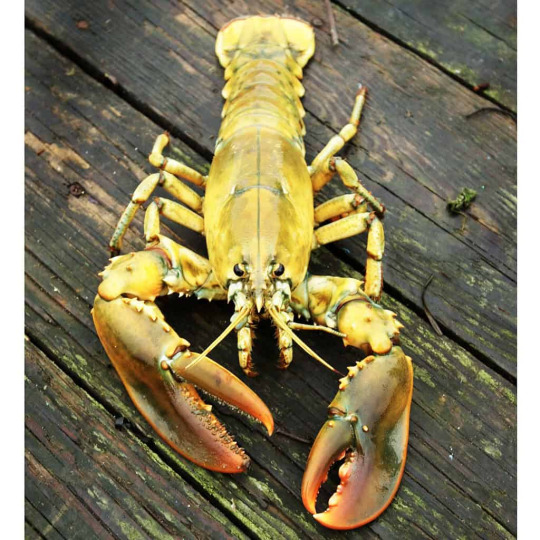



(Images: 6 pictures of lobster color varaints. Let to right, top to bottom: blue, red, yellow, calico, split, white. End ID)
American lobsters are found in cold, coastal waters of the Atlantic Ocean from the USA to northern Canada. They are famously highly abundant around the state of Maine, which has the world's largest lobster fishery. They prefer rocky bottoms with plenty of places to hide. Despite those big claws, lobsters are rather timid. They spend a lot of their time hiding and are quick to use their tails to flee. If pressed, they will use their powerful claws to fight. While occasionally active in the day, lobsters are mostly nocturnal, coming out at night to find food. Speaking from personal experience, I did a night SCUBA dive in Maine and there were so many lobsters I could barely see the seafloor. American lobsters are territorial and will fight over food, shelter, and mates. When they live in close quarters, lobster will establish a dominance hierarchy based largely on size. They use chemical signatures to identify themselves and communicate. The diet of an American lobster mostly consists of small invertebrates such as worms, slugs, clams, and crabs, but they also eat carrion and algae and seagrass. Lobsters in captivity have been known to engage in cannibalism, but this has never been seen in the wild.

(Image: a lobster molting. The carapace on the back of the cephalothorax has come off and the soft-bodied lobster is emerging through the gap created. End ID)
The American lobster is a popular food source and so is fished heavily in the northern USA and Canada, with the state of Maine and Atlantic province having the largest industries. The vast majority of lobster fishing is done with special lobster traps, sometimes called pots. These are cages baited with dead fish that have funnel-shaped entrances. The idea is that the shape of the entrance lets lobsters in, but makes it hard for them to get out. Humorously, lobster traps have been found to be incredibly inefficient, all but the largest lobsters can enter and leave freely. The lobsters that get caught tend to be the ones unlucky enough to be in the trap when it's pulled up. Bait has been found to comprise a large portion of the diet of lobsters in Maine and individual lobsters have been known to claim traps as their territory and fight off others trying to enter them. Modern traps are also required to have holes allowing lobsters below the size limit to leave easily. The inefficiency of lobster traps has allowed the population to remain stable despite the incredibly heavy fishing. in addition, there are many regulations to protect the species, including requirements to release small lobsters and egg-bearing females. There is no lobster aquaculture doe to how long it takes them to reach a usable size. Commercial lobster fishing started with poor laborers who could get them cheap due to how abundant the lobsters were in the area. As with so many other things, the rich came, took an idea created by the poor, and drove up prices so much the original people could no longer afford their own invention. Lobsters are traditionally cooked by boiling, usually with the lobster still alive at the time. The ethics of live cooking lobsters is debated. Some insist their brains do not have the regions responsible for feeling pain while others point out they still respond negatively to stimuli and therefore can still feel some kind of distress even if it isn't the same as human pain. Some jurisdictions have made live boiling illegal and require the lobster to be dead first. Freezing the lobster or a stab through the cephalothorax are offered as more humane than boiling. The American lobster is classified as least concern by the IUCN, meaning they are not at risk of extinction.
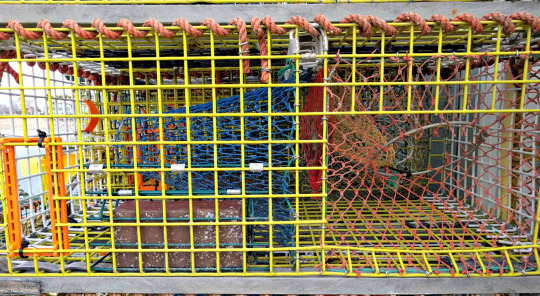
(Image: a modern lobster trap. It is a rectangular wire cage painted yellow. There are two chambers inside. The first chamber has two openings to the outside and is where bait is placed. The second chamber has another funnel-shaped opening to the first chamber and is intended to trap the lobsters within. An opening on the side of the second chamber allows small lobsters to escape. A brick is used to weigh the cage down. End ID)
#wet beast wednesday#lobster#american lobster#homarus americanus#crustaceans#decapod#decapoda#marine biology#biology#zoology#ecology#animal facts#informative#educational#invertebrate#invertebrates#image described
86 notes
·
View notes
Text

By Tsarli at English Wikipedia, CC BY-SA 3.0
#japanese spider crab#crab#decapod#crustacean#arthropod#wet [critter creature or beast] wednesday#wednesday poll
64 notes
·
View notes